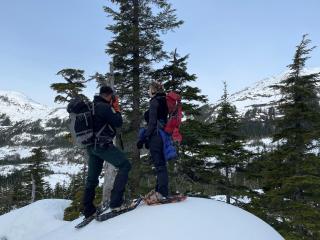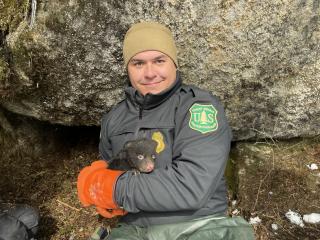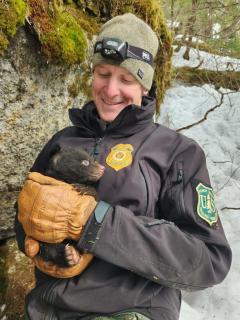Bear with us while we remove your momma’s data-collecting collar

ALASKA – At first, it may not seem like they go together – a black bear research study and Forest Service law enforcement officers. But one look at photos of Cordova Law Enforcement Officers Andy Morse and Dale Clukey, with a “cute as can be” bear cub is sure to change people’s minds.
The story behind the pictures brings forth tales of patrolling in a law enforcement boat with Forest Service and Alaska Department of Fish and Game biologists at the start of spring. It’s a story about navigating through icy bays, traversing steep, snow-covered mountainsides on snowshoes and trekking near occupied bear dens while hearing the sounds of newly born cubs. It concludes with a state biologist crawling into small spaces to tranquilize sleeping bears with a ‘jab stick’ to carefully remove their GPS-equpiped collars.

In early April, Officers Morse and Clukey set out in their patrol boat, the Kristine Fairbanks, navigating the west side of Prince William Sound. The duo was helping the ADF&G’s Charlotte Westing and the Forest Service’s Brandt Meixell find hibernating bears with tracking collars.
“There’s always some risk associated with handling bears, but the adults are so docile,” commented Morse. “That is because of the state of torpor they are in from denning all winter. And the cubs are not developed enough to be threatening.”
The agency has supported biologists with capturing, collaring and retrieving the tracking devices since the start of the Prince William Sound Black Bear Research Study in 2017.

The collar-mounted transmitters record GPS locations every five hours and transmit data via satellite for remote download. The devices are programmed to release after three years. The collars can then be recovered and analyzed for additional data such as bear activity level and ambient temperature. On occasion, the release mechanism on a collar fails, which means the device must be manually removed.
The most recent journey by this state, federal and law enforcement partnership led the foursome to the winter den of a 25-year-old sow and her cub. The momma bear had to be tranquilized before biologist Westing could safely enter the den to retrieve the collar holding five years of valuable data.
While the extraction took place, Officers Morse and Clukey happily stepped in to keep the two-month-old bear cub warm just outside where her hibernating parent slept. Knowing the tranquilized bear could be sedated for several hours, the cub was quickly positioned back close to her mother after the work was complete. “It’s magical holding a tiny bear cub,” reminisced Morse. “For perspective this female cub was about the size of a 10-week-old lab puppy.”
The study is using data collected from about 50 collared bears to examine seasonal patterns of movement and behavior. Starting in 2007, and continuing for the next ten years, it is believed that black bear numbers in Prince William Sound may have declined. This study aims at understanding the black bear population better with the goal of providing improved management.
